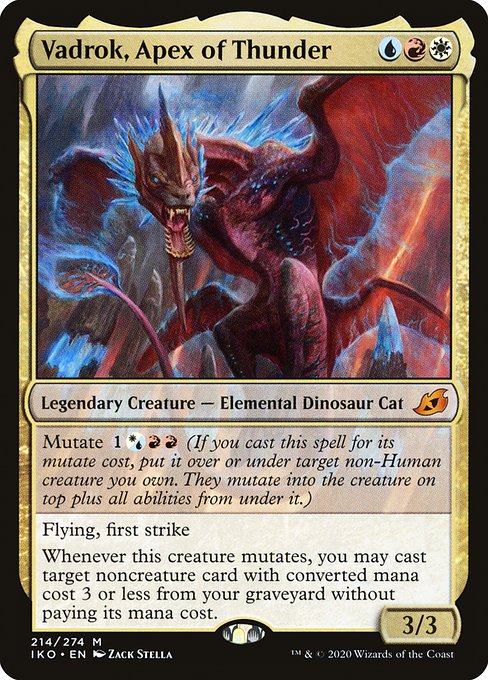
Image courtesy of Scryfall.com
AI Art Trends in MTG: Vadrok in Focus
What happens when the wild energy of MTG meets the current wave of AI-assisted art? We’re seeing a surge of experimentation that blends the old-school thrill of a card frame with the near-infinite palette of generative tools. Vadrok, Apex of Thunder—an Ikoria standout with its triple-color identity and gravity-defying Mutate mechanic—offers a perfect lens to explore these trends. The card’s very design invites a conversation about how AI-generated concepts can inform, augment, or reimagine iconic MTG visuals without replacing the human touch that gives each frame its heartbeat 🧙🔥💎.
Vadrok as a Mutate Masterpiece: Visuals that Invigorate Prompting
Ikoria: Lair of Behemoths introduced Mutate as a design philosophy—layering a new body over an existing one to unleash hybrid forms and fresh abilities. Vadrok embodies that spirit both mechanically and visually. With a mana cost of {U}{R}{W} and a Mutate cost of {1}{W/U}{R}{R}, the card sits at a crisp three mana, balancing speed with the promise of powerful polymorphs. When you mutate Vadrok, you lean into a cascade of possibilities: flying, first strike, and the option to cast a noncreature card from your graveyard for free if its mana value is 3 or less. That mutate dynamic—two creatures in one moment—translates beautifully to AI workflows, where prompts layer layers, overlays, and color-energy to achieve fresh silhouettes and chromatic harmonies.
- Colorful prompts: Vadrok’s color identity (R/U/W) invites triadic palettes—crimson heat, electric blue, and crystalline white. AI artists often start with tri-color prompts to capture that volatile, high-energy vibe that Ikoria is known for.
- Layered forms: The mutate mechanic mirrors how AI can compose multiplicative forms—one creature component atop another—yielding visually dynamic, multi-torso beasts that still feel MTG-flavored.
- Energetic motion: Vadrok’s flying and first strike cues encourage motion-oriented prompts—wind-swept lines, wing arcs, and lightning-silver edge glints—that translate well into AI-generated variants and concept art explorations 🎨🎲.
The Ikoria Aesthetic: Art that Feels Built to Be Reimagined
Ikoria’s art direction, led by prolific talents like Zack Stella, embraces a monster-centric, kinetic look. AI workflows thrive on that density: you can prompt for layered textures, scale patterns, and chivalrous, dragon-like silhouettes that still honor the original mythology of the frame. Vadrok’s multi-species lineage—a legendary Elemental Dinosaur Cat—offers a perfect prompt ladder: start with the base Vadrok figure, then ask the AI to explore additional forms (e.g., armored scales, feathered crests, storm-energy cores) while preserving key motifs like the tri-color aura and the signature Mutate overlay. The result is art that feels both familiar and boldly new, a hallmark of contemporary MTG AI exploration 🧙🔥💎.
“Mutate is a visual metaphor for how AI can remix a concept without erasing its roots—new forms emerge from the same seed, each with its own heart.”
Crafting Prompts, Curating Art, and Respecting the Frame
For players and collectors who love the idea of AI art, Vadrok serves as a practical case study in prompt discipline. You can explore three guiding practices:
- Anchor the base: Start with Vadrok’s core traits—Flying, First Strike, the Mutate cost, and the triple-color identity. Let the AI layer in new textures while preserving the creature’s silhouette and color energy.
- Prompt responsibly: When experimenting with AI art, keep prompts aligned with MTG’s lore: creatures mutate under stress and evolve into something that feels game-ready, not entirely alien. This balances fan-friendly aesthetics with the card’s mechanical identity.
- Showcase a family of variants: Generate several Vadrok-inspired takes—one with electric storm motifs, one with primordial forest hues, a third with crystalline thunder—then curate a gallery that highlights what each variant can teach us about design, color theory, and storytelling.
From Digital Studio to Tabletop: Value, Collectibility, and Community
Vadrok’s rarity is mythic, a rarity that carries both prestige and a bit of mystique in the market. Its non-foil and foil finishes both have their own charm, and the card’s edhrec rank sits within a spectrum that signals enduring interest among commanders who love creature combos and graveyard shenanigans. While AI-generated artistry adds a new layer of fan interpretation, the card’s identity remains rooted in Wizards’ solid frame design and the Ikoria universe—where monsters collide with mutate logic to create something greater than the sum of its parts 🧙🔥⚔️🎨.
As collectors navigate the evolving art landscape, Vadrok also serves as a bridge between the tactile and digital worlds. A beautiful print, a sleek digital illustration, or a coordinated set of AI-assisted variants—all share a common thread: a reverence for the core game mechanics and a curiosity about how new tools can illuminate them. The Kairos of AI art—prompt, refine, iterate—parallels the way players approach deck building: experiment, refine, and ultimately embrace the version that speaks to them most.
Practical Tips for Fans and Builders Alike
If you’re curious about weaving Vadrok’s energy into your own MTG journey, here are quick ideas:
- Play Vadrok in a tri-colored commander shell that exploits graveyard recursion and mutate synergies.
- Use AI-inspired art prompts to craft alt-art concepts for personal collection displays or social media spots—always with respect to card art licensing and the spirit of the game.
- Follow Ikoria-era design cues to spark new AI prompts: scaly textures, storm-lit horizons, and layered beast forms that feel like they could thunder into a battlefield near you.
In the end,Vadrok, Apex of Thunder stands as a vibrant emblem of how MTG’s visual language continues to evolve alongside technology. It’s a reminder that art—whether painted by hand or imagined by a neural network—thrives on collaboration, conflict, and color. And if you’re hunting for gear that carries that same electric vibe into everyday life, consider keeping your collection protected and proudly displayed with stylish accessories that speak to the same tri-colored imagination you bring to the table ✨🧪🎲.